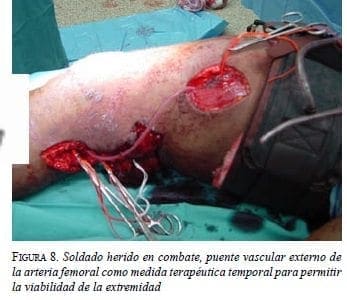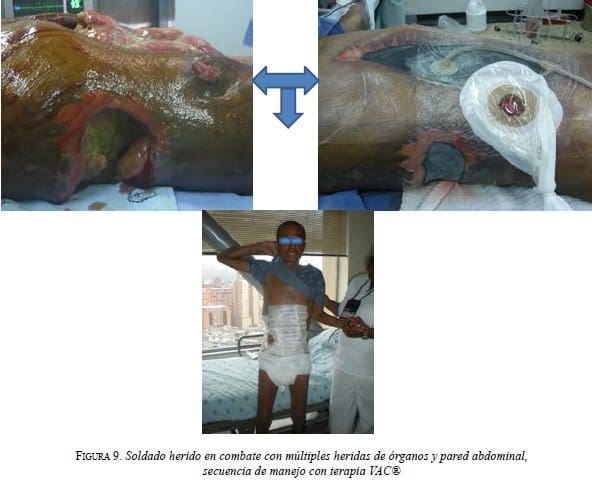2. El paciente presentó una lesión por fragmento de granada en el miembro inferior derecho, que causó fractura del fémur y lesión de la arteria poplítea. El enfermero del equipo EMEREVAC controló la hemorragia aguda con compresión local y torniquete. Posteriormente, en el helicóptero de rescate, el médico practicó un puente vascular externo para garantizar la viabilidad de la extremidad y hacer la reparación definitiva en el Hospital Militar Central (figura 8).
3. El paciente fue herido en combate con una granada de fusil de asalto, sufriendo graves y múltiples lesiones de hígado, riñón, yeyuno, colon, estómago, pulmón y pared abdominal. Fueron necesarias numerosas intervenciones quirúrgicas y tratamientos con equipos multidisciplinarios, incluyendo terapia VAC®, para permitir la supervivencia y recuperación del paciente (figura 9).
Conclusiones
– La estrategia de desarrollo del plan de atención médica en el paciente herido en combate, debe contemplar todas las variables que se pueden incluir dentro de un análisis de la matriz de Haddon.
– El Plan Pantera, como pilar de atención en las Fuerzas Militares de Colombia, ha sido exitoso, permitiendo una mejor probabilidad de supervivencia del herido en combate.
– Todo plan de atención médica del paciente traumatizado y críticamente enfermo, y en especial en la medicina militar, debe estar fundamentado en la fortaleza de la formación continua académica y educativa de cada uno de los integrantes de los equipos de trabajo.
“Panther strategy”: Military Trauma in Colombia
Abstract
Background. The impact on medical care for the wounded resulting from a guerrillas and, more recently, drug trafficking and criminal gangs, long irregular warfare in Colombia originated the development of a strategy of health care oriented to ensure optimal, quick, and effective treatment seeking the most likely possibility of survival of the wounded and a satisfactory rehabilitation.
Methods. The strategic military trauma care plan began to be developed in the year 2000 and was implemented in the year 2014 under the name of Panther strategy, and was based on the Haddon model that establishes seven successive steps of action and military health care. We present the results of this project, from its inception until the year 2010.
Results. In the period from January 2005 to December 2010 there were 8631 combat injuries of the military forces of Colombia; 2462 were killed at the scene of the military operations (28.5%). The actions of EMEREVAC and GATRA teams resulted in a very significant reduction in mortality in the battle field. In-hospital mortality for patients with
major trauma (ISS >15) at the last level of attention (Hospital Militar Central) was 2.3%.
Conclusions. The strategy of developing the plan of care of patients wounded in combat should take into account all possible variables that ca be included in an analysis of the Haddon matrix. The “Panther plan” as a pillar of care in the military forces of Colombia has been successful, allowing a better chance of survival of the wounded in combat. All health care plans for the traumatized and critically ill patients, and especially in military medicine, must be based on the strength of the continuing education and academic formation of each one of the members of the teams.
Key words: military medicine; hospitals, military; wounds and injuries; multiple trauma.
Bibliografía
1. Rasmussen TE, Dubose JJ, Asensio JA, Feliciano DV, Fox CJ, Nuñez TC, Sise MJ; Military Liaison Committee of the American Association for the Surgery of Trauma, et al. Tourniquets, vascular shunts, and endovascular technologies: Esoteric or essential? A report from the 2011 AAST Military Liaison Panel. J Trauma Acute Care Surg. 2012;73:282-5.
2. Christoffel T, Gallagher SS. Injury prevention and public health practical knowledge, skills and strategies. Second edition. Boston: Jones and Bartlett Publishers; 2006.
3. Arias C, Villamil E, Gutiérrez J, Morales H, Sánchez MW. Trauma vascular periférico de guerra en Colombia: análisis epidemiológico de ocho años. Rev Colomb Cir. 2012;27(Supl.):26.
4. Gómez D, Katime I, Sánchez MW. Laparoscopia una herramienta diagnóstica y terapéutica en trauma abdominal cerrado secundario a onda explosiva. Rev Colomb Cir.
2010;25(Supl.):31.
5. Gutiérrez J, Katime I, Sánchez MW. Ecocardiograma, estudio indispensable para pacientes estables con lesiones no precordiales por arma de fragmentación. Rev Colomb Cir. 2010;25(Supl.):30-1.
6. Sánchez MW. Epidemiología en Colombia del trauma grave en militares. Rev Colomb Cir. 2011;26(Supl.):40.
7. Haddon W. Advances in the epidemiology of injuries as a basis for public health policy. Public Health Reports. 1980;95:411-21.
8. Asensio JA, Kuncir EJ, García-Núñez LM, Petrone P. Femoral vessel injuries: Analysis of factors predictive of outcomes. J Am Coll Surg. 2006;203:512-20.
9. Dau AA, Tloba S, Daw MA. Characterization of wound infections among patients injured during the 2011 Libyan conflict. East Mediterr Health J. 2013;19:356-61.
10. Søreide K, Petrone P, Asensio JA. Emergency thoracotomy in trauma: Rationale, risks, and realities. Scand J Surg. 2007;96:4-10.
11. Asensio JA, Petrone P, Pérez-Alonso A, Verde JM, Martin MJ, Sánchez MW , et al. Contemporary wars and their contributions to vascular injury management. Eur J Trauma Emerg Surg. DOI 10.1007/s00068-014-0430-7.
12. Eastridge BJ, Mabry RL, Seguin P, Cantrell J, Tops T, Uribe P, et al. Death on the battlefield (2001-2011): Implications for the future of combat casualty care. J Trauma Acute Care Surg. 2012;73(Suppl.):S431-7.
13. Krueger CA, Wenke JC, Ficke JR. Ten years at war: Comprehensive analysis of amputation trends. J Trauma Acute Care Surg. 2012;73(Suppl.5):S438-44.
14. Sheridan RL, Shumaker PR, King DR, Wright CD, Itani K, Cancio LC. Case 15-2014: A man in the military who was injured by an improvised explosive device in Afghanistan. N Engl J Med. 2014;370:1931-40.
15. Cannon JW, Fischer JE. Edward D. Churchill as a combat consultant: Lessons for the senior visiting surgeons and today´s military medical corps. Ann Surg. 2010;251:566-72.
16. Lairet JR, Bebarta VS, Burns CJ, Lairet KF, Rasmussen TE, Renz EM, et al. Prehospital interventions performed in a combat zone: A prospective multicenter study of 1003 combat wounded. J Trauma Acute Care Surg. 2012;21(Suppl.1):S38-42.
17. Cancio LC, Pruitt BA Jr. Management of mass casualty burn disasters. Int J Disasters Med. 2004;2:114-29.
18. Mason PE, Eadie JS, Holder AD. Prospective observational study of United States (US) Air Force Critical care Air Transport team operations in Iraq. J Emerg Med. 2011;41:8-13.
Correspondencia: William Sánchez, MD, FACS
Correo electrónico: sanchez.william@cable.net.co
Bogotá, D.C., Colombia



